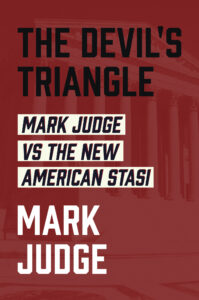Bored With Comparing Trump to Hitler, This Writer Compares Him to … Chairman Mao

It’s a real shame. I was looking forward to reading Red Memory: The Afterlives of China’s Cultural Revolution by journalist Tania Branigan. China’s Cultural Revolution, roughly 1966-1976, was one of the bloodiest and most insane periods in the history of communism. It was an attempt to try and purge communist China of all Western ideas, from Christianity to capitalism. An estimated two million were killed, and 30 million persecuted and punished. While she’s a liberal journalist for Britain’s Guardian, Branigan is a very sharp writer. She’s a rational adult — or so I thought. She would clearly describe the horrifying evil of the Cultural Revolution and not fall back on some hysterical comparison of Mao’s genocidal follies with … four years of peace and prosperity under President Donald Trump.
Right? Is that too much to ask?
Branigan doesn’t even make it through the Introduction without, yes, bringing up President Trump. The Cultural Revolution may have been bad, Branigan writes, but almost as awful is today’s modern equivalent. “I didn’t expect to see a West so detached from fact, so prone to zealotry, so divided, so deranged by conspiracy theories,“ she observes after returning home from China after several years there reporting. “I certainly didn’t expect that, in a country lauding itself as the world’s greatest democracy, a demagogue would turn to a violent mob to halt the peaceful transfer of power.” People in America are actually questioning experts!
On the other hand, “to draw a line from left-wing students in the West to Red Guards, as some have done – is not only silly but offensive.” I suppose we should just stop being surprised that Western media leftists are actually superstitious zealots, out to hunt and burn some witches.
Good Prose, Wasted
As I said, this is a shame, because Branigan is a splendid writer. Her imagery is powerful, her sentences elegant. She gets the basics right. The Cultural Revolution was the brainchild of Chairman Mao Zedong. He cooked it up after the failure of his economic Great Leap Forward, a program of collectivization that resulted in tens of millions of deaths. Mao saw the Cultural Revolution as a way to turn things around: “Our objective is to struggle against and crush those persons in authority who are taking the capitalist road … so as to facilitate the consolidation and development of the socialist system.”
Particularly enthusiastic in their extremism were university students, known as the Red Guard. In Red Memory, Branigan is searing in her descriptions of the horror. The Cultural Revolution was “an ideological crusade — a drive to reshape China’s hearts and souls … . People were to be remade or removed.” The ten years of the revolution, Branigan writes, “were savage, unrelenting and extraordinarily destructive. The violence and hatred terrorized the nation, annihilated much of its culture and killed key leaders and thinkers.”
The Logical Endpoint of Cancel Culture
No one was safe, as factions split into smaller factions and the left turned on anyone who wasn’t fully committed to a new society. Teachers, intellectuals, artists, the religious — all were humiliated, removed and murdered. Education, once a way of going status and respect, was suspect. Ultimately, Branigan writes, “the campaign was bent upon spiritual purity, and the true realization of the perfect communist society, erasing the bourgeois contamination which had tainted the Party — and the country it ruled — since taking power in 1949.” It was hell.
In his book The People’s Revolution: A Cultural History, China expert Frank Dikötter observes that Mao hoped his movement would make China the pinnacle of the socialist universe and have him become “the man who leads planet Earth into communism.” A flyer from the time outlines the plan:
The whole party must follow Comrade Mao Zedong’s instructions, hold high the great banner of the proletarian Cultural Revolution, thoroughly expose the reactionary bourgeois stand of those so called ‘academic authorities’ who oppose the party and socialism, thoroughly criticize and repudiate the reactionary bourgeois ideas in the sphere of academic work, education, journalism, literature, art and publishing, and seize the leadership in these cultural spheres.
Burning Churches and Books
The result of this is evident in pictures from time: purges, torture, rallies, propaganda posters and executions. “We were told that we needed to use violence to destroy a class, spiritually and physically,” one eyewitness account reveals. “That was justification enough for torturing someone. They weren’t considered human anymore.” Red Guards destroyed Buddhist statues and burned down Catholic churches, as they represented a “black religion” and “old thinking.”
The Peking Union Medical Hospital, founded by the Rockefeller Foundation in 1921, was renamed the “anti-Imperialist Hospital.” Wang Guangmei, the wife of President Liu Shaoqui, who was purged when he was insufficiently committed to Mao, was forced to wear a necklace of pingpong balls as a mockery of her pearls and formal wear. Women’s choirs were forced to sing Mao’s praises.
Remember How the MAGA Guard Terrorized Harvard and Stanford?
Yeah, that all sounds like just the kind of thing championed by Donald Trump and modern conservatives, doesn’t it. It doesn’t resemble in any way the censorship, statue-toppling, speech codes or crusade for socialist “spiritual purity” on the part of today’s college students.
Branigan laments that people in the West no longer trust experts. She doesn’t acknowledge the Russia hoax, the COVID totalitarianism, the transgender insanity, or the deep corruption of the FBI, CIA and other national security organizations. In a deep irony, she makes no mention of the possibility that COVID itself was a lab leak from a Chinese Communist facility. Or that Western politicians helped the Chinese Communist Party and our corrupt leftist media to smother that grenade.
There is no regret for people, not in 1960s China but in today’s America, who lose careers for stating simple truths. Branigan can’t bring herself to admit that in concrete an obvious ways, liberals have become very much like communist Chinese zealots. College students who berate and even kidnap speakers they don’t agree with are the new Red Guards.
There is a great book inside of Red Memory, like a prisoner craving escape. How dreary that Branigan embodies the censorship and fanaticism of those she condemns in her own work.
Mark Judge is a writer and filmmaker in Washington, D.C. His new book is The Devil’s Triangle: Mark Judge vs the New American Stasi.


